
‘A sea of blood in the church’: Survivors recount Myitkyina’s lethal crackdown
Eyewitnesses describe how protesters were killed or maimed in the Kachin Sate capital on March 8 right after a Catholic nun knelt and implored security forces not to harm them.
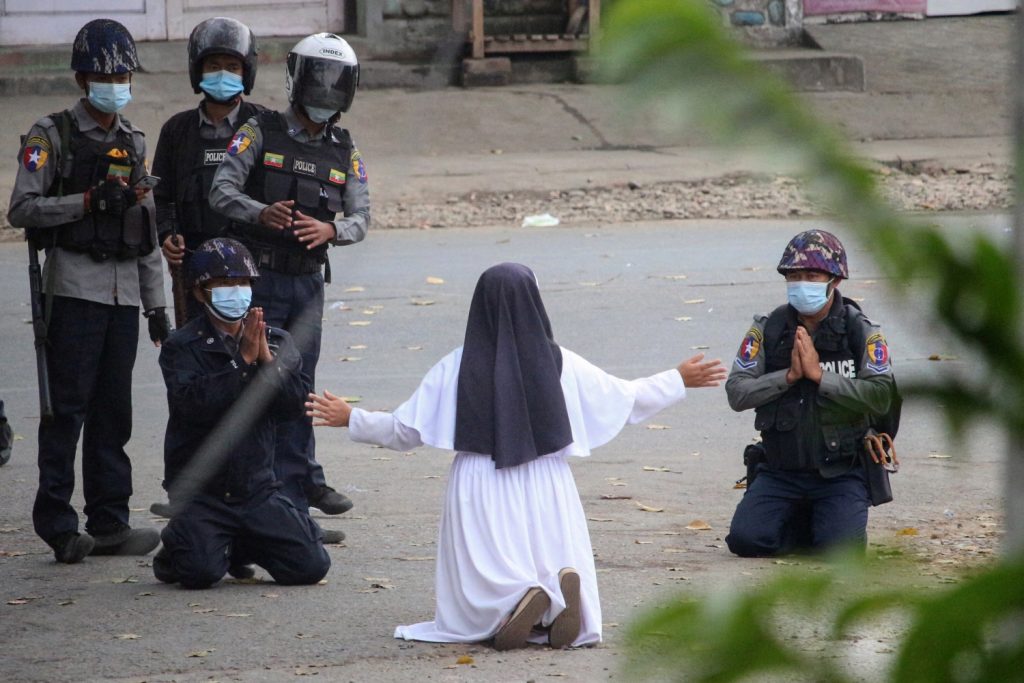
"Please, don’t shoot or beat the children. They are young and very afraid of you," Catholic nun Sister Ann Rosa Nu Tawng tells security forces, shortly before they open fire on protesters at Myitkyina's St Columban’s Cathedral on March 8. (Myitkyina News Journal | AFP)
KACHIN STATE IS MAJORITY CHRISTIAN
MARCH 13, 2021
MARCH 13, 2021
By NU NU LUSAN and EMILY FISHBEIN | FRONTIER
On the morning of March 8, protesters in the Kachin State capital, Myitkyina, reached a standoff with the police and army in front of Saint Columban’s Cathedral in the city’s Aung Nan Yeik Thar ward. In what has quickly become one of the iconic images of the protests, a Roman Catholic nun stood between the police and protesters and begged for mercy. Tragically, security forces opened fire moments later; by day’s end, two lay dead and another two were seriously injured.
Frontier spoke to the nun, as well as three young protesters, to piece together what happened that day and the context surrounding it. As well as the shootings, eyewitnesses described beatings, looting and mass arrests. Although deeply shaken by the violence, they said the experience had made them more determined to bring down the military regime.
“Young people in Myitkyina are frustrated. We will continue going out on the street. We will not stop until we get what we want,” said Htu Mai, the pseudonym of a young Kachin woman.
A plea for restraint
On March 8, hundreds of supporters of the three main protest movements in Myitkyina – involving a multi-ethnic student and youth group, a Kachin youth group, and a teacher-led group of striking public servants – gathered in the streets by the cathedral at around 9am.
Within an hour, the crowd had swelled to thousands. Police and soldiers barricaded the area with their vehicles and began chasing the protesters, who fled in different directions. Some sought refuge in the cathedral compound and others hid in nearby houses.
Brang Ja, a young Kachin who asked that his real name not be used, was among hundreds of protesters who sought refuge in the cathedral. “We quickly locked the church doors,” he said. “They surrounded the church from all sides, so we were only peeking out.”
Htu Mai hid in an alley behind the cathedral as security forces fired rubber bullets, stun grenades and slingshots. Anyone filming the crackdown was targeted for arrest and some had their phones confiscated, she said.
With roads leading out of the area blocked by security forces, Htu Mai jumped a barbed wire fence and from the vantage point of another alley, watched as they beat protesters, sometimes whipping their heads with slingshot straps, before arresting them.
“They dragged out women who were hiding in other people’s houses,” she said. In one house, there were mass arrests, including of people hiding in the toilet, said Htu Mai. “They beat arrested protesters badly. They didn’t even leave the women alone,” she said. A total of 91 people were arrested that day, and most remain in custody
.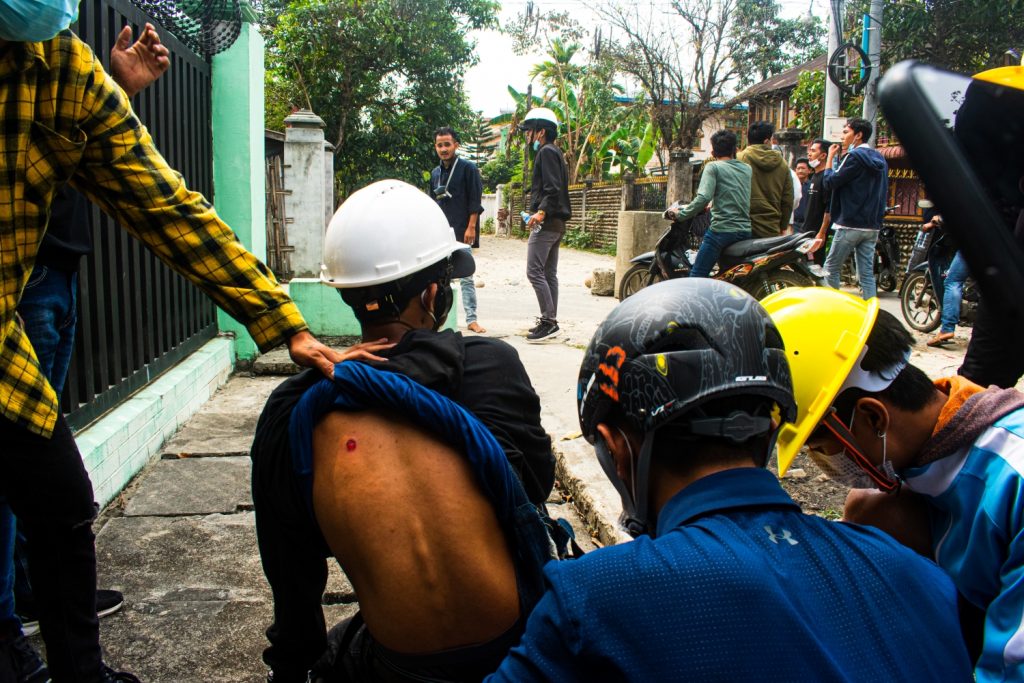

A protester sustains a rubber bullet injury in front of St Columban’s Cathedral during a crackdown on March 8 that saw two killed and two seriously injured. (Supplied)
On nearby streets, separate protest groups made their way toward the church compound and converged. Having escaped, Htu Mai joined them.
Htu Mai said that with many police and soldiers blocking all sides of the church compound, she and other protesters stood on a nearby street and chanted. “They threw stun grenades at us but we chanted that we, the people, had to unite; we didn’t run away but continued to chant our slogans,” said Htu Mai. As protesters were enveloped by clouds of teargas, shopkeepers threw bags of ice to them so they could soothe their irritated eyes.
Inside the cathedral, Brang Ja and the other protesters communicated with the different protest groups by phone. Meanwhile, the protests outside intensified and some began throwing water bottles and rocks.
At about 11am, Sister Ann Rosa Nu Tawng, a nun and the head nurse at the Mali Gindai clinic in the cathedral compound, walked out and knelt in front of the police, as she had also done on February 28.
“I told them, ‘Please, don’t shoot or beat the children. They are young and very afraid of you … Whatever the command from above, please do not shoot, beat or arrest them,’” she said, while some protesters left the church compound to gather behind her. The police knelt in return, and according to Ann Rosa Nu Tawng, told her they were just following orders and asked her to return to the church.
“They asked me, ‘Aren’t you afraid? If you keep doing this, we are going to take action under the law.’ I replied, ‘You can kill me or arrest me; I will not move,” the nun said. Her efforts to avert further bloodshed were to no avail, however. Soon after noon, the security forces opened fire with live and rubber bullets and tear gas.
“There was no way to escape,” she said. “I didn’t know what to do; I just stood there and prayed to God for help.”
‘This is how they torture the people’
Brang Ja, who had also left the cathedral compound to confront the police line, attempted to run back inside but was blinded by tear gas and smoke. “At that time, we heard, ‘Someone got hit! Someone got hit!’ When we looked back, a man had fallen down and his brain was coming out. We carried him into the clinic [in the cathedral compound],” he said.
Ann Rosa Nu Tawng also came out to help. “I ran toward [the victim]. [Police] threw tear gas and it was very smoky,” she said. “I called some of the protesters to help me carry him inside but when I looked at him, his brain was coming out and he was bleeding badly.”
Moments later, Brang Ja and other protesters helped her carry a second victim, a young man also shot in the head, into the cathedral.
Next to Htu Mai, a woman fell to the ground after a bullet entered her arm, and protesters carried her inside. Htu Mai kept running and hid in another alley.
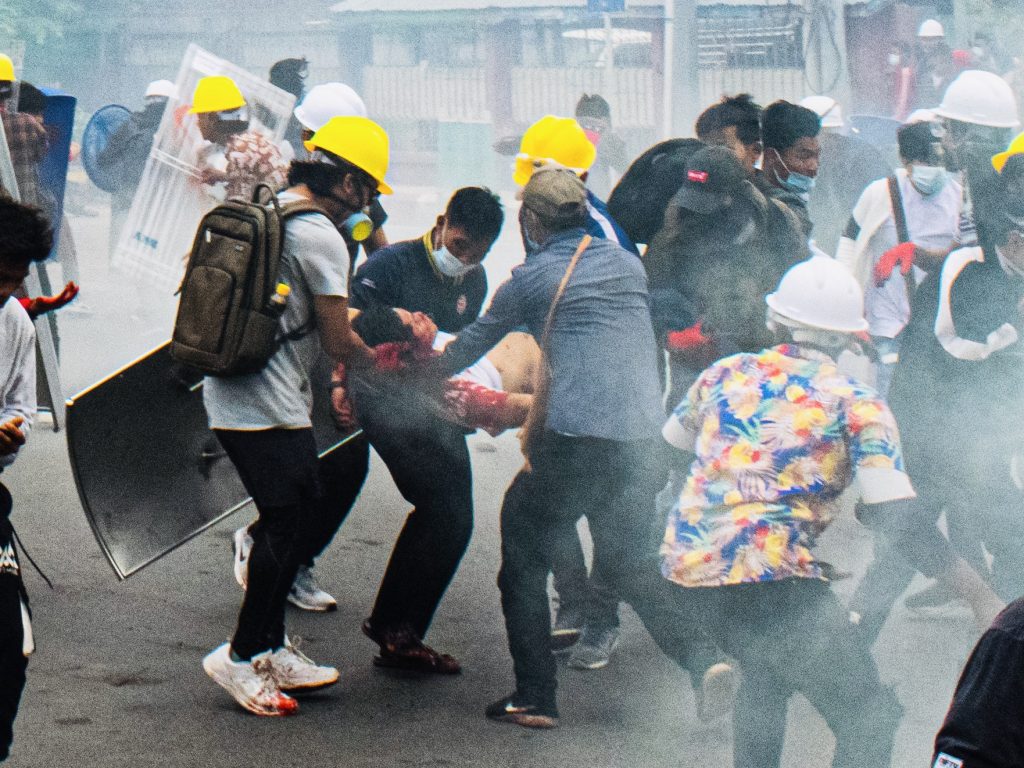
On nearby streets, separate protest groups made their way toward the church compound and converged. Having escaped, Htu Mai joined them.
Htu Mai said that with many police and soldiers blocking all sides of the church compound, she and other protesters stood on a nearby street and chanted. “They threw stun grenades at us but we chanted that we, the people, had to unite; we didn’t run away but continued to chant our slogans,” said Htu Mai. As protesters were enveloped by clouds of teargas, shopkeepers threw bags of ice to them so they could soothe their irritated eyes.
Inside the cathedral, Brang Ja and the other protesters communicated with the different protest groups by phone. Meanwhile, the protests outside intensified and some began throwing water bottles and rocks.
At about 11am, Sister Ann Rosa Nu Tawng, a nun and the head nurse at the Mali Gindai clinic in the cathedral compound, walked out and knelt in front of the police, as she had also done on February 28.
“I told them, ‘Please, don’t shoot or beat the children. They are young and very afraid of you … Whatever the command from above, please do not shoot, beat or arrest them,’” she said, while some protesters left the church compound to gather behind her. The police knelt in return, and according to Ann Rosa Nu Tawng, told her they were just following orders and asked her to return to the church.
“They asked me, ‘Aren’t you afraid? If you keep doing this, we are going to take action under the law.’ I replied, ‘You can kill me or arrest me; I will not move,” the nun said. Her efforts to avert further bloodshed were to no avail, however. Soon after noon, the security forces opened fire with live and rubber bullets and tear gas.
“There was no way to escape,” she said. “I didn’t know what to do; I just stood there and prayed to God for help.”
‘This is how they torture the people’
Brang Ja, who had also left the cathedral compound to confront the police line, attempted to run back inside but was blinded by tear gas and smoke. “At that time, we heard, ‘Someone got hit! Someone got hit!’ When we looked back, a man had fallen down and his brain was coming out. We carried him into the clinic [in the cathedral compound],” he said.
Ann Rosa Nu Tawng also came out to help. “I ran toward [the victim]. [Police] threw tear gas and it was very smoky,” she said. “I called some of the protesters to help me carry him inside but when I looked at him, his brain was coming out and he was bleeding badly.”
Moments later, Brang Ja and other protesters helped her carry a second victim, a young man also shot in the head, into the cathedral.
Next to Htu Mai, a woman fell to the ground after a bullet entered her arm, and protesters carried her inside. Htu Mai kept running and hid in another alley.

Protesters carry an injured person during the March 8 crackdown in Myiktyina’s Aung Nan Yeik Thar ward. (Supplied)
In the cathedral, Ann Rosa Nu Tawng and two other nuns tended the wounded. “There was a sea of blood in the church,” she said. “I was coughing, dizzy, nauseated and couldn’t see properly because of the tear gas … I felt like it was the end of the world.”
As they waited for an ambulance, the nuns tried to staunch the victims’ bleeding. “We gave first aid to the two patients who had been shot in the head, but we weren’t really sure whether they were already dead because their heads had burst open,” she said.
The number of police cars patrolling the area delayed by 30 minutes the arrival of the volunteer ambulance crew that picked up the two men shot in the head, and it was another half hour before an ambulance collected the woman who had been shot in the arm. The patients were taken to the private Malizup Hospital in Myae Myint ward, about three kilometres from the cathedral, and a man shot in the stomach while protesting near the railway station a few blocks from the cathedral was admitted to the same hospital shortly after.
Back at the cathedral clinic, Ann Rosa Nu Tawng and her team were treating protesters who had been wounded by rubber bullets and police batons. “Our minds were everywhere; so many people were in the church, and some were crying. It was chaotic,” she said.
Outside the cathedral, eyewitnesses watched as authorities looted vehicles.
“They broke the car [windows] and took purses and all the valuable things,” said Htu Mai. “I saw live bullet shells on the street … they were gold and bronze in colour. They used both live and rubber bullets and shot us with slingshots. This is how they torture the people.”
By 2pm, the two men who had been shot in the head were pronounced dead. That afternoon, police hosed blood off the streets, while in the evening residents gathered for interfaith candlelight vigils for the victims.
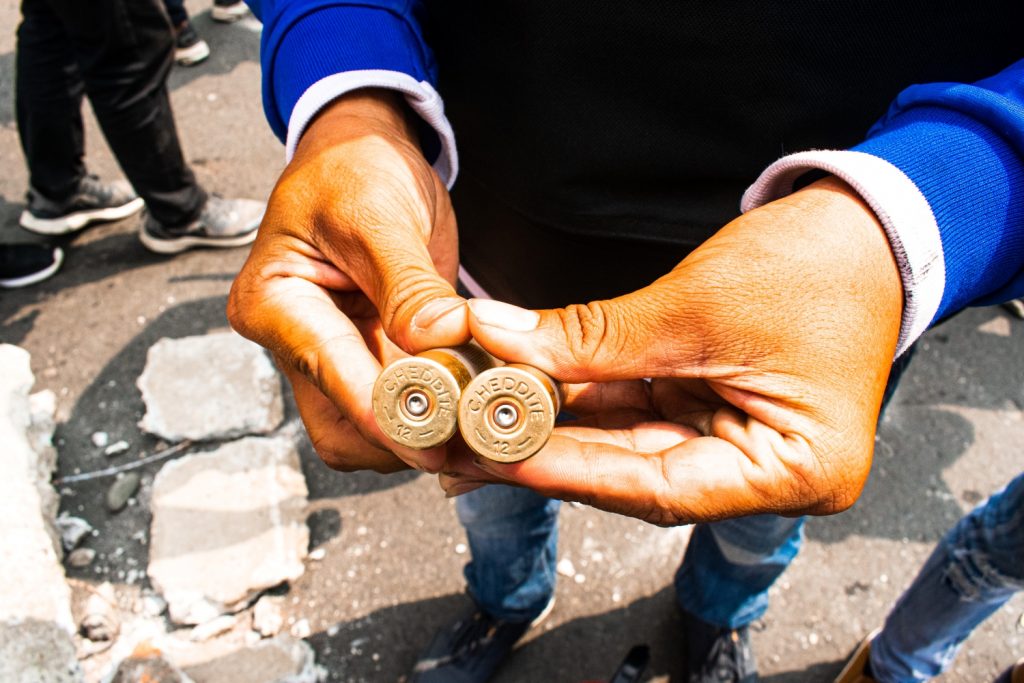
In the cathedral, Ann Rosa Nu Tawng and two other nuns tended the wounded. “There was a sea of blood in the church,” she said. “I was coughing, dizzy, nauseated and couldn’t see properly because of the tear gas … I felt like it was the end of the world.”
As they waited for an ambulance, the nuns tried to staunch the victims’ bleeding. “We gave first aid to the two patients who had been shot in the head, but we weren’t really sure whether they were already dead because their heads had burst open,” she said.
The number of police cars patrolling the area delayed by 30 minutes the arrival of the volunteer ambulance crew that picked up the two men shot in the head, and it was another half hour before an ambulance collected the woman who had been shot in the arm. The patients were taken to the private Malizup Hospital in Myae Myint ward, about three kilometres from the cathedral, and a man shot in the stomach while protesting near the railway station a few blocks from the cathedral was admitted to the same hospital shortly after.
Back at the cathedral clinic, Ann Rosa Nu Tawng and her team were treating protesters who had been wounded by rubber bullets and police batons. “Our minds were everywhere; so many people were in the church, and some were crying. It was chaotic,” she said.
Outside the cathedral, eyewitnesses watched as authorities looted vehicles.
“They broke the car [windows] and took purses and all the valuable things,” said Htu Mai. “I saw live bullet shells on the street … they were gold and bronze in colour. They used both live and rubber bullets and shot us with slingshots. This is how they torture the people.”
By 2pm, the two men who had been shot in the head were pronounced dead. That afternoon, police hosed blood off the streets, while in the evening residents gathered for interfaith candlelight vigils for the victims.

Shells from bullets fired near St Columban’s Cathedral on March 8. (Supplied)
On March 9, funerals were held in Radha Gaung ward on the outskirts of the city for U Cho Tha, 62, a Muslim retired primary school teacher who had worked in a remote border area, and for Ko Zin Min Htet, 23, a Buddhist who worked at a goldsmith shop and lived with his mother and two older sisters.
Thousands attended from across the city’s diverse ethnic and religious communities. Mourners waved three-finger salutes, a pro-democracy gesture, chanted “Military dictatorship must fall!” and “Let the Civil Disobedience Movement succeed!”, and placed colourful flowers on the caskets, said Brang Ja, who attended the funeral of Zin Min Htet.
An interfaith memorial service was planned on March 10 at the site where the men were gunned down, but was cancelled due to a heavy police presence.
After the violence, some media outlets including Radio Free Asia reported that the Kachin Independence Organisation had said it would protect Kachin State residents protesting peacefully against the coup if security forces continued to violently suppress them.
Weeks of tension
The crackdown on March 8 marked the culmination of weeks of building tension in Myitkyina since protests began there a month earlier.
On the evening of February 14, police and soldiers fired rubber bullets to disperse crowds demonstrating outside a Tatmadaw-occupied power plant. On February 18, police cracked down on protests in front of the city’s teacher training college, beating one teacher and breaking her hand, and the next day stormed downtown protests with batons and slingshots, arresting 10. With the Tatmadaw now in control of the city’s power supply, Brang Ja said electricity was cut in alternating wards on a daily basis and he heard from friends that police were stopping people and searching their bags, and arresting them if they found evidence of participation in protests, such as flags or hardhats.
But there had been few violent confrontations before March 8. Htoi Shawng, the pseudonym for a protest leader, told Frontier that three or four people had suffered slingshot injuries to the head prior to the deadly crackdown. He estimated that about 200 people had been arrested in Myitkyina, but many had been released following mediation facilitated by the Peacetalk Creation Group, comprised of Kachin businesspeople who have long negotiated between conflict actors in the state.
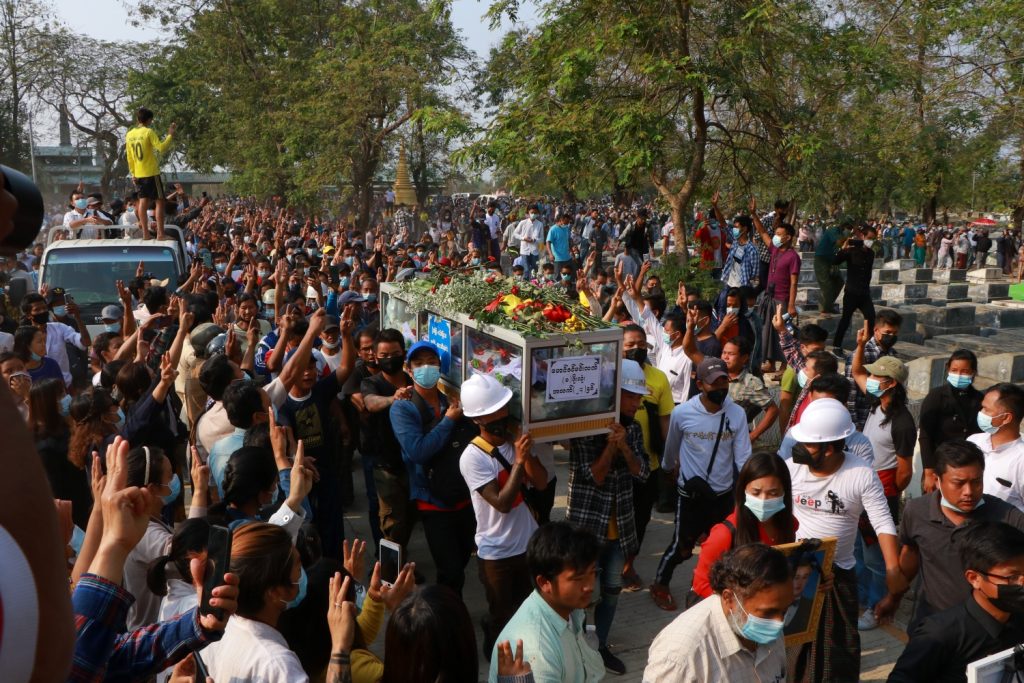
On March 9, funerals were held in Radha Gaung ward on the outskirts of the city for U Cho Tha, 62, a Muslim retired primary school teacher who had worked in a remote border area, and for Ko Zin Min Htet, 23, a Buddhist who worked at a goldsmith shop and lived with his mother and two older sisters.
Thousands attended from across the city’s diverse ethnic and religious communities. Mourners waved three-finger salutes, a pro-democracy gesture, chanted “Military dictatorship must fall!” and “Let the Civil Disobedience Movement succeed!”, and placed colourful flowers on the caskets, said Brang Ja, who attended the funeral of Zin Min Htet.
An interfaith memorial service was planned on March 10 at the site where the men were gunned down, but was cancelled due to a heavy police presence.
After the violence, some media outlets including Radio Free Asia reported that the Kachin Independence Organisation had said it would protect Kachin State residents protesting peacefully against the coup if security forces continued to violently suppress them.
Weeks of tension
The crackdown on March 8 marked the culmination of weeks of building tension in Myitkyina since protests began there a month earlier.
On the evening of February 14, police and soldiers fired rubber bullets to disperse crowds demonstrating outside a Tatmadaw-occupied power plant. On February 18, police cracked down on protests in front of the city’s teacher training college, beating one teacher and breaking her hand, and the next day stormed downtown protests with batons and slingshots, arresting 10. With the Tatmadaw now in control of the city’s power supply, Brang Ja said electricity was cut in alternating wards on a daily basis and he heard from friends that police were stopping people and searching their bags, and arresting them if they found evidence of participation in protests, such as flags or hardhats.
But there had been few violent confrontations before March 8. Htoi Shawng, the pseudonym for a protest leader, told Frontier that three or four people had suffered slingshot injuries to the head prior to the deadly crackdown. He estimated that about 200 people had been arrested in Myitkyina, but many had been released following mediation facilitated by the Peacetalk Creation Group, comprised of Kachin businesspeople who have long negotiated between conflict actors in the state.

Thousands wave the three-finger salute as they attend the March 9 funeral of Ko Zin Min Htet, 23, who was killed during the crackdown on protesters the previous day. (La Beng)
Htoi Shawng said that despite the repeated use of force by security forces, protesters would continue to demonstrate peacefully.
In common with other ethnic nationality areas, the protesters in Kachin seek not only the reversal of the coup, but also the abolition of the military-drafted 2008 Constitution and its replacement by a charter that grants federal rights to the seven ethnic states.
Htoi Shawng said there had sometimes been disagreements among the ethnically diverse protesters in Myitkyina, with some protesters pushing the interests of their own communities, and he hoped they could unite around the goal of a federal democratic union.
The March 8 violence has left many protesters with deep emotional scars.
“I was traumatised because I have never seen anything like it,” said Brang Ja, adding that he could not sleep on the night of March 8. “Now, when I think about it, I still remember it clearly,” he told Frontier on March 9.
Ann Rosa Nu Tawng said her courageous appeal to police that day had left her badly shaken.
“I am a human being, too, so I also wanted to run away to somewhere safe, but I thought about it and realised I should not run away; I have to stand up for these young people,” she said. “When we [sisters] see the brutality of the military and the killing, we cannot sleep at night.”
However, Ann Rosa Nu Tawng and the other interviewees remain undeterred in their resolve to stand against dictatorship.
“Everyone has a responsibility to promote peace in our country. We must all come together in unity to solve this crisis,” she said. “This is not the time to discriminate based on our background, beliefs, race or ethnicity; everyone should join hands.”
Brang Ja said the violence had only made him more motivated to continue being involved in the protest movement, which he predicted would only grow stronger.
“I try to be strong and tell others that we cannot cry too much; we have to keep going. We still have many things to do,” he said. “I cannot stay quiet.”
Htoi Shawng said that despite the repeated use of force by security forces, protesters would continue to demonstrate peacefully.
In common with other ethnic nationality areas, the protesters in Kachin seek not only the reversal of the coup, but also the abolition of the military-drafted 2008 Constitution and its replacement by a charter that grants federal rights to the seven ethnic states.
Htoi Shawng said there had sometimes been disagreements among the ethnically diverse protesters in Myitkyina, with some protesters pushing the interests of their own communities, and he hoped they could unite around the goal of a federal democratic union.
The March 8 violence has left many protesters with deep emotional scars.
“I was traumatised because I have never seen anything like it,” said Brang Ja, adding that he could not sleep on the night of March 8. “Now, when I think about it, I still remember it clearly,” he told Frontier on March 9.
Ann Rosa Nu Tawng said her courageous appeal to police that day had left her badly shaken.
“I am a human being, too, so I also wanted to run away to somewhere safe, but I thought about it and realised I should not run away; I have to stand up for these young people,” she said. “When we [sisters] see the brutality of the military and the killing, we cannot sleep at night.”
However, Ann Rosa Nu Tawng and the other interviewees remain undeterred in their resolve to stand against dictatorship.
“Everyone has a responsibility to promote peace in our country. We must all come together in unity to solve this crisis,” she said. “This is not the time to discriminate based on our background, beliefs, race or ethnicity; everyone should join hands.”
Brang Ja said the violence had only made him more motivated to continue being involved in the protest movement, which he predicted would only grow stronger.
“I try to be strong and tell others that we cannot cry too much; we have to keep going. We still have many things to do,” he said. “I cannot stay quiet.”
No comments:
Post a Comment